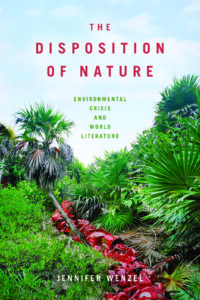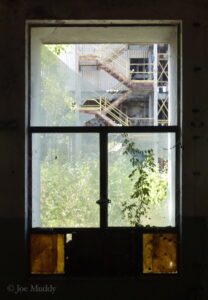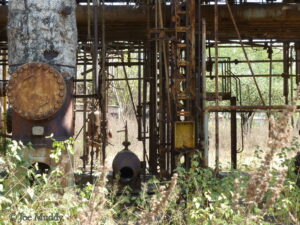By Jennifer Wenzel
“Unevenly universal” is how Rob Nixon describes human vulnerability to environmental harm in Slow Violence and the Environmentalism of the Poor. I’ve been thinking again about that phrase, as a global pandemic starkly reveals both the universal susceptibility of Homo sapiens (among other species) to a new pathogen and the uneven ways the novel coronavirus has ravaged communities and nations, exposing the persistent effects of longstanding histories of inequality. To adapt Nixon’s observation about the Anthropocene, we may all be in the COVID emergency, but we’re not all in it in the same way.
 I began writing The Disposition of Nature: Environmental Crisis and World Literature before Dipesh Chakrabarty’s 2009 “Climate of History” essay (as well as facts on the ground, and in the atmosphere and oceans) put global warming squarely on the agenda of the humanities and social sciences. The book was released just as COVID-19 made its fateful species jump to humans. Even as the world seems suddenly, utterly changed, the questions that propel this work are more urgent than ever.
I began writing The Disposition of Nature: Environmental Crisis and World Literature before Dipesh Chakrabarty’s 2009 “Climate of History” essay (as well as facts on the ground, and in the atmosphere and oceans) put global warming squarely on the agenda of the humanities and social sciences. The book was released just as COVID-19 made its fateful species jump to humans. Even as the world seems suddenly, utterly changed, the questions that propel this work are more urgent than ever.
Indeed, one central concern in The Disposition of Nature is with world-imagining, by which I mean imagining a world and one’s place in it, at scales ranging from the cells of our bodies to the planet as a whole. Literature and film are crucial sites of such imagining, both for characters within texts and the readers and audiences who engage them. These acts of world-imagining are one example of “Reading for the Planet,” as I write in the book’s introduction: “reading from near to there,” across geographic and experiential divides, at more than one scale. How can we calibrate the earth or planet at risk in environmental crisis with both the globe in globalization and the world in World Literature?
In this work, I sought to challenge three problematic assumptions: that environmental concern is a unique invention of the West, to be shared with the rest of the world; that globalization is a recent phenomenon, beginning only in the twentieth century; and that European imperialism is “over,” in both its material effects and its relevance as a framework for analyzing the present. The literary texts and films constellated here come from Africa, South Asia, and the Caribbean, with intertextual gestures toward the US and Europe. Yet my arguments range far beyond the field of postcolonial studies, by elucidating fundamental relationships between nature and the imagination.
I also intend “reading for the planet” in a more literal sense, one central to the mission of ASLE and the environmental humanities: the hope that my (or your) readerly intelligence might do something for the planet, in the world, as an environmentalist praxis in the face of cascading and overlapping crises of ecological and social injustice. Yet this sense of civic commitment – recently formulated as “Emergency Humanities” – demands critical awareness of all of the ways the literary has shaped what we talk about when we talk about nature.
“Just as surely as a walk in the woods,” I write in the book’s introduction, “nature becomes known to us through narrative and other patterns of imagining.” Perhaps this notion seems banal, a bedrock assumption for environmental humanities. But instead of focusing on environmentally-themed literature or understanding ecocriticism as a “solution” to environmental crisis (perhaps by cultivating what Lawrence Buell describes as “environmental imagination”), we must also reckon with how all literature and other cultural forms offer tacit answers to environmental questions that we don’t even ask, by quietly shaping what counts as “nature,” “environment,” “crisis,” or even “human.” I was thrilled when Alejandro Durán allowed me to use his photograph Vena from his Washed Up series on the book’s cover: the red stream of plastic running through the landscape invites the defamiliarizing double-take question – “Wait, what is that?” – which The Disposition of Nature asks of cultural imagining writ large.
This is another way of saying that literature – and literary criticism – has also been complicit in socioenvironmental injustice, in part by naturalizing ideas about what is natural, or just. Like David Mazel, I understand this approach to nature as akin to Edward W. Said’s transformative analysis of how discourse produced “the Orient.” With “the disposition of nature,” then, I’m interested in how disparate ideas about what nature is are at stake in conflicts over how it is inhabited and used. One consequential way that nature has been disposed – both materially and imaginatively – is through what I call “resource logics” that understand nature as something other than human, disposed as a resource for human use, and subject to human control.
Back in the old days when I taught in a classroom (rather than on a screen), I’d ask my students to look at – rather than out of – the window, which I could reliably expect to be dirty, streaked with city dust and grime. Notice how, when you look at it, the dirty glass isn’t actually transparent, I’d suggest. What’s the difference between looking through that glass and being out in the world? How does the window frame delimit what you see? How is your view just slightly different from that of the classmate sitting next to you, because of the position and the angle from which you look? Or very different from that of the classmate on the other side of the room? These questions offer a concrete, embodied way of explaining the rather abstract notion of mediation: the formal strategies and aesthetic devices through which texts represent the world, the sometimes elusive difference between representation and reality, and the singular (yet socially embedded) perspective of each reader. These big-picture questions are not only larger than any particular period-, region-, or genre-based field within literary studies; they exceed the discipline itself, involving questions of perspective, power, and historically-entrenched ways of seeing (and shaping) the world, and the earth. While literature certainly holds no monopoly over such mediation, the habits of mind and modes of inquiry associated with literary studies are indispensable in teasing out how mediation works and why it matters.

Union Carbide factory site in Bhopal, India: view through a broken window in the control room, c. 2009. Photo by Joe Muddy.
This is another sense of reading at stake in The Disposition of Nature, which models something not unlike what Anna Tsing calls the “arts of noticing”: a practice of paying close attention to how texts work at the level of form, style, and rhetoric, in order to understand the work they might do in the world, for better and for worse. Maya Jasanoff, a scholar of Science and Technology Studies (STS), has argued that Indra Sinha’s novel Animal’s People “may have done more to revive international interest in Bhopal, and thus to touch the conscience of the world, than decades of medical or legal action” (“Bhopal’s Trials”). While such a claim may be the kind of thing that partisans of the literary like to hear, our discipline has the tools to grasp just what the novel has done, and, more importantly, the how of that doing.

Plants grow around abandoned methyl isocyanate unit, Union Carbide factory site, Bhopal, c. 2009. Photo by Joe Muddy.
Attending to the complex narrative structure, exuberant multilingualism, and incendiary intertextuality of Animal’s People, chapter 4 (“How Far Is Bhopal?”) demonstrates the necessity of close reading joined with thick contextualization to begin to make sense of the ongoing disaster at Bhopal – as well as the broader predicament of living on a planet remade at the molecular scale by industrial chemistry. A similar method drives chapter 2 (“Hijacking the Imagination: How to Tell the Story of the Niger Delta”), which considers the formal strategies through which poetry, fiction, photography, and documentary film confront the transnational dynamics of what geographer Michael Watts theorizes as “petroviolence” in Nigeria. Both chapters take a contrapuntal view to trace links between these quintessential sites of ecodisaster and sites and subjects far away: an Agent Orange-ravaged Vietnam; the US Gulf Coast; consumers of world literature, petroleum, and household products full of dioxin.
This is not close reading in the hygienically formalist mode of the American New Critics’ Cold War-era attempts to quarantine the text from history and politics, but instead a worldly attentiveness to how texts make legible (or obscure) the flows of matter, power, and ideas across bodies and biomes, along the lines of Stacy Alaimo’s notion of trans-corporeality. This mode of reading draws upon other disciplines – including law, geography, political ecology, history, anthropology, and STS. Yet this interdisciplinary traffic should move in both directions: The Disposition of Nature demonstrates how a supple understanding of cultural imagining and narrative logics – a facility with the literary – can foster more robust accounts of the past, present, and future of global inequality, in order to energize movements for justice and livable futures.
 Jennifer Wenzel is an Associate Professor at Columbia University in the City of New York, jointly appointed in the Department of English and Comparative Literature and the Department of Middle Eastern, South Asian, and African Studies. Her work on postcolonial studies and energy and environmental humanities has been published in journals including PMLA, Resilience, and Modern Fiction Studies. With Imre Szeman and Patricia Yaeger, she co-edited Fueling Culture: 101 Words for Energy and Environment (Fordham, 2017). Her first monograph, Bulletproof: Afterlives of Anti-colonial Prophecy in South Africa and Beyond (Chicago and KwaZulu-Natal, 2009), was awarded Honorable Mention for the Perkins Prize by the International Society for the Study of Narrative.
Jennifer Wenzel is an Associate Professor at Columbia University in the City of New York, jointly appointed in the Department of English and Comparative Literature and the Department of Middle Eastern, South Asian, and African Studies. Her work on postcolonial studies and energy and environmental humanities has been published in journals including PMLA, Resilience, and Modern Fiction Studies. With Imre Szeman and Patricia Yaeger, she co-edited Fueling Culture: 101 Words for Energy and Environment (Fordham, 2017). Her first monograph, Bulletproof: Afterlives of Anti-colonial Prophecy in South Africa and Beyond (Chicago and KwaZulu-Natal, 2009), was awarded Honorable Mention for the Perkins Prize by the International Society for the Study of Narrative.
